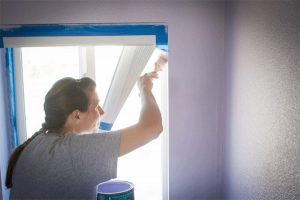Proper preparation is essential whenever you want to paint a particular surface. Regardless of the age of the surface, whether new or old, there are often numerous marks on the wall like scrapes, grazes, nail holes and much more. These noticeable marks become extremely hard to remove especially after the application of paint. It is, however, simple to fill holes such as those brought about by nails. Simply take a knife and smoothen fillers over the scrape or hole. Larger holes like those seen on plasterboards, however, dealt with in two different ways.
a. Using a primer on bare wood before you start painting.
 To begin with, an expanding form filler, which is the best option accessed from Masters Home Improvement. The other choice is to cut a small piece of wood that correctly fits the size, and stick it using glue. Even as you do this, always remember to leave a small allowance from the wall’s surface. After it is in place, use an appropriate filler to any existing gaps.
To begin with, an expanding form filler, which is the best option accessed from Masters Home Improvement. The other choice is to cut a small piece of wood that correctly fits the size, and stick it using glue. Even as you do this, always remember to leave a small allowance from the wall’s surface. After it is in place, use an appropriate filler to any existing gaps.
The Older cover, on the other hand, you have the option of using old paint for an undercoat. Carefully examine each corner of the house especially the bathrooms and kitchen for any signs of molds. Treat this condition with the right anti-mold procedure.
In addition to this, remember to countercheck the same areas for any water or steam collected on them and wipe it off. By so doing, you would be taking the right measures towards ensuring that your paint does not flake. Mix methylated spirit and warm water in the ratio of one to eight to remove wallpapers. Paint it then allows it soak for half an hour before scraping clean.
b. Clean surfaces with sugar soap and enable them to dry
First, make the surface smooth by sanding. There is the urgent need to ensure that all surfaces are flat including previously filled holes and old paint edges. With a flat surface all through, there is little chance of ending up with ridges at the end of your painting job. Finish this step by dusting off the surface.
Consider old paint to be your number one enemy. If the already existing color is in a poor state, ensure that you remove it completely before applying fresh paint. Scrape any old paint with a scraper until you attain maximum satisfaction. Professional painting experts suggest that for you to make sure that your new paint does not flake because of not binding itself to the wall, ensure you keep the wall clean of any old chipped paint.
Use a medium sandpaper to smoothen the walls after you have eliminated all chipped paint from the edges of the walls. Some surfaces, however, require thorough scrapping the entire wall. Regardless of the type of scrapper you use, whether electric or blade and paint remover, ensure you first read and understand the instructions set before you begin. Sand then dust clean and wash off the whole area with sugar water.
Prepare to paint by covering your windows with strips of masking tape. It is an appropriate measure to take to avoid spreading paint to windowpanes and comfortably brush edges of the window. Apply the same technique on doors with brass fillings and handles for a less frustrating paint job.
For one that is not sure whether the old paint is flaking or not, a simple test can help you come to the right conclusion. Using a knife, cut through the paint and stick take over it. Pull off the tape in a gentle manner and observe the results. If the paints peel off with the sticker, this is an indication of flaking, therefore, the need to remove it.